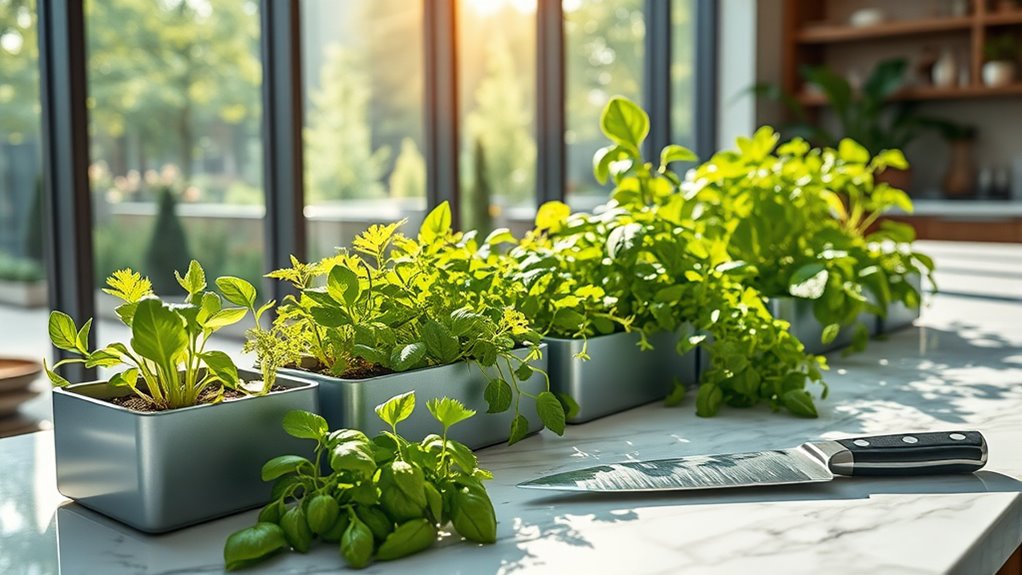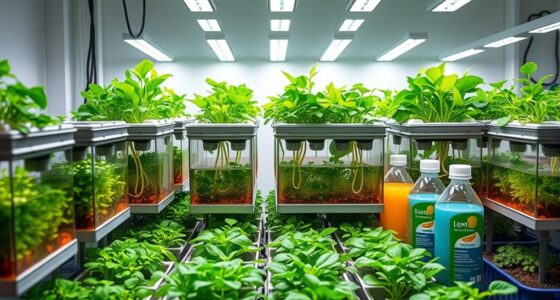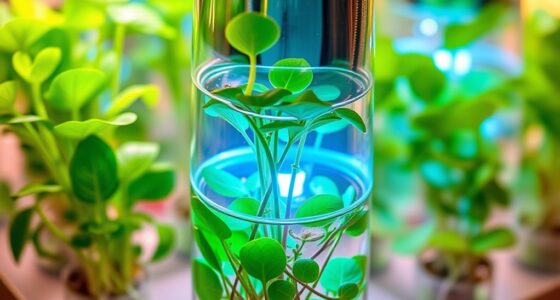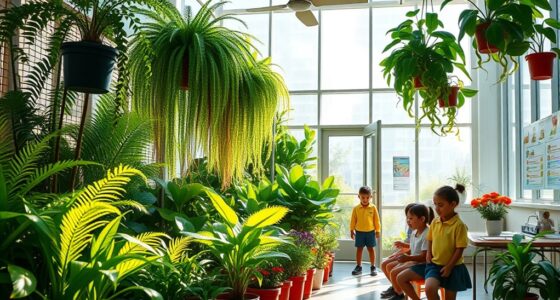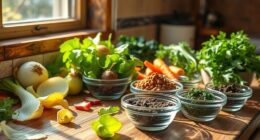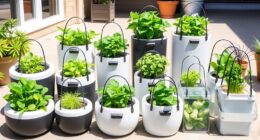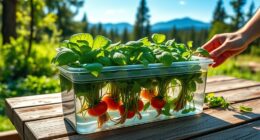To elevate your culinary creations, I recommend exploring versatile indoor gardens like the Ahopegarden hydroponic system, which supports multiple plants with energy-efficient LED lights. The DUNCHATY stackable planters are great for herbs and greens, while the MCombo cold frame offers a cozy space for delicate plants. High-quality seeds keep your options diverse, and choosing a system that fits your space and needs guarantees year-round freshness. Keep exploring to find the perfect setup for your kitchen.
Key Takeaways
- Choose compact, modular systems like stackable planters or hydroponic kits for easy integration into busy kitchens.
- Prioritize high-quality, diverse seed varieties such as heirloom lettuce and herbs for culinary versatility.
- Opt for systems with adjustable lighting, automated watering, and climate control to ensure healthy, fast-growing plants year-round.
- Incorporate stylish, space-efficient greenhouses or cold frames that enhance kitchen decor while protecting plants.
- Select user-friendly setups with clear instructions and maintenance features to simplify ongoing care and maximize freshness.
20,000+ Lettuce Seeds for Indoor and Outdoor Gardening
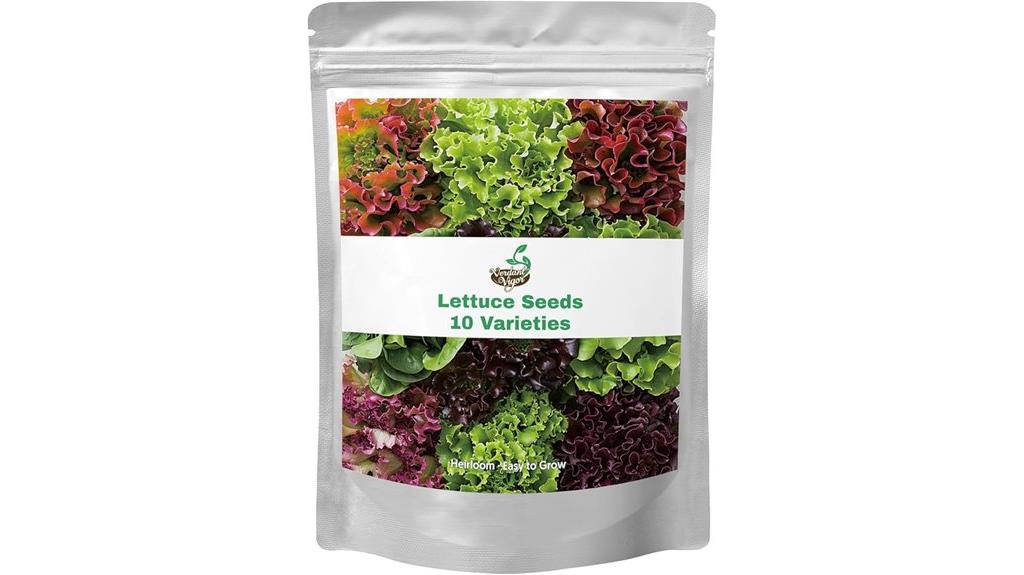
Are you a chef or food enthusiast looking to elevate your culinary creations with fresh, homegrown ingredients? I’ve discovered over 20,000 heirloom, non-GMO lettuce seeds perfect for indoor and outdoor gardening. With 10 varieties like bibb, iceberg, romaine, and buttercrunch, you can cultivate tender, flavorful greens for salads, wraps, and juices. These seeds are easy to grow in gardens, containers, hydroponics, or vertical setups. Packaged in resealable bags, they stay viable for years when stored properly. Sourced in the USA, they guarantee high germination rates. Growing your own lettuce adds freshness and a personal touch to every dish.
Best For: chefs, food enthusiasts, home gardeners, and anyone interested in growing their own fresh, healthy lettuce for culinary use or personal enjoyment.
Pros:
- Over 20,000 heirloom, non-GMO lettuce seeds available in multiple varieties for diverse planting options
- Easy-to-follow growing instructions and included plant markers make cultivation simple for beginners and experts alike
- Long shelf life when stored properly, with seeds sourced and packaged in the USA ensuring high germination rates
Cons:
- Requires proper storage in cool, dark places to maintain seed viability over time
- Growing indoors or in small spaces may require additional setup like containers or grow lights
- Limited to lettuce varieties; does not include other vegetables or greens
GROWLIKECHEF Autoflowering Marijuana Growing Guide
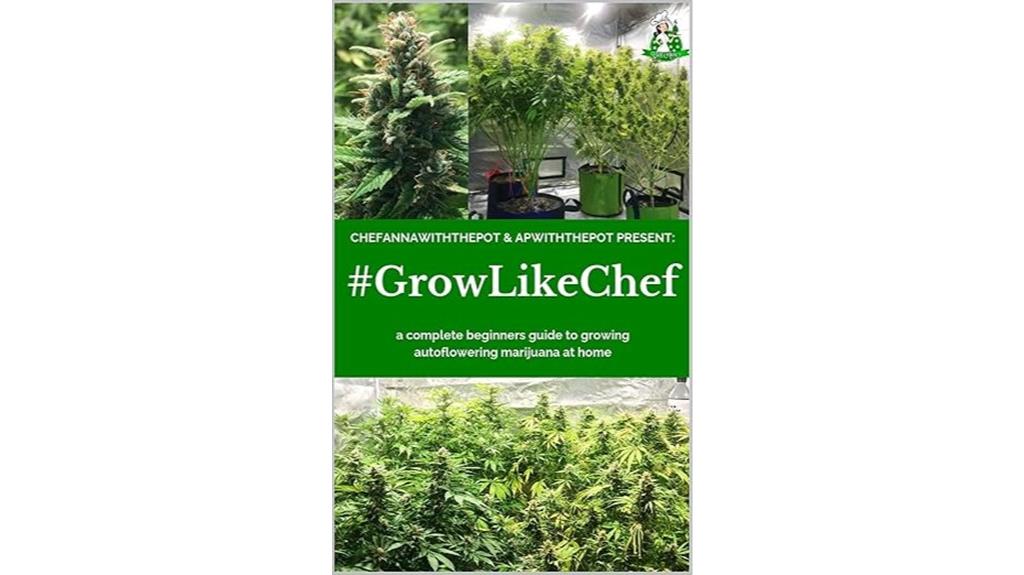
The “#GROWLIKECHEF” Autoflowering Marijuana Growing Guide stands out as an ideal resource for beginners enthusiastic to grow cannabis at home with confidence. I appreciate its straightforward, step-by-step approach that breaks down each growth phase, including feeding schedules and essential materials. It’s praised for its clarity and practicality, making it perfect for those new to cultivation. Though some critique its limited troubleshooting and visuals, many find it a reliable starting point. I see it as a simple, structured manual that helps beginners navigate autoflowering cannabis growth without overwhelming them, making it a valuable tool in indoor gardening for chefs.
Best For: beginners interested in growing autoflowering cannabis at home who need a clear, straightforward, and practical guide to start their cultivation journey.
Pros:
- Easy-to-follow, step-by-step instructions suitable for novices
- Practical guidance on feeding schedules and essential materials
- Highly praised for clarity and simplicity, making cultivation accessible
Cons:
- Limited troubleshooting advice and visual aids for plant problems
- Some nutrient recommendations may seem oversimplified or unrealistic for beginners
- Criticized for superficial content and poor production quality with minimal depth
Ahopegarden Hydroponics Growing System Kit with Grow Light
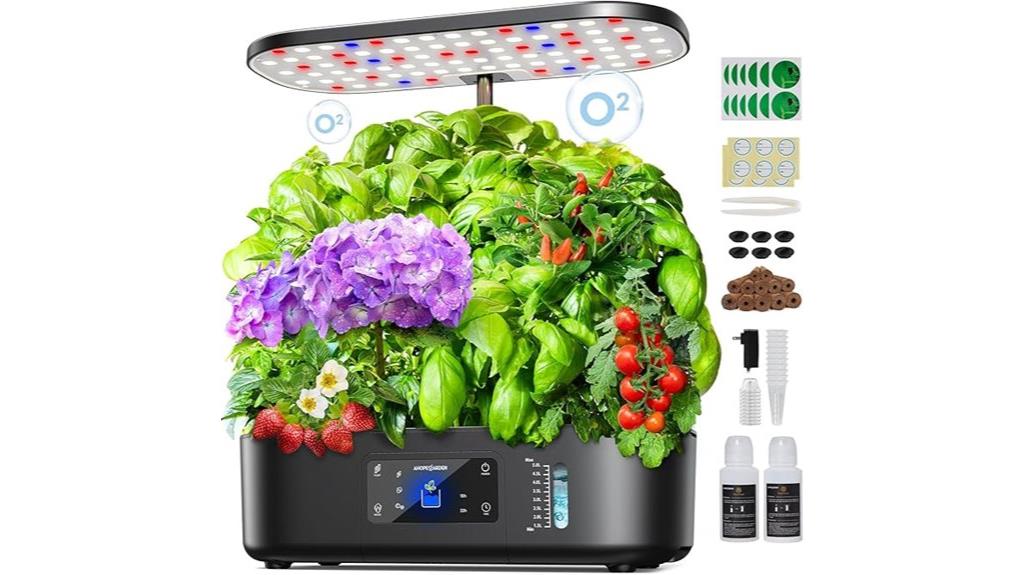
For chefs seeking a sleek, high-tech way to grow fresh herbs and greens indoors, the Ahopegarden Hydroponics Growing System Kit with Grow Light offers an ideal solution. Its modern design features a compact, vertical profile with a black ABS finish and 17 adjustable planting heights, making it perfect for small spaces. The full-spectrum LED grow light, with dual modes and a 22-hour cycle, boosts plant growth, flowering, and fruiting. The system supports up to 12 herbs or leafy greens simultaneously and includes a quiet 5L water tank with a circulation pump. It’s user-friendly, energy-efficient, and perfect for cultivating fresh, organic produce year-round.
Best For: culinary professionals, urban gardeners, and tech-savvy individuals seeking a stylish, efficient indoor hydroponic system to grow fresh herbs and greens year-round.
Pros:
- Sleek, modern design that complements contemporary interiors and makes a stylish gift.
- Supports up to 12 plants simultaneously with adjustable planting heights and full-spectrum LED lighting for optimal growth.
- Energy-efficient, quiet operation with a user-friendly LCD touchscreen and minimal maintenance.
Cons:
- Limited water capacity (5L), requiring frequent refilling during intensive growth periods.
- May be less suitable for large-scale or outdoor gardening needs due to its compact size.
- Initial setup and calibration of the LED light and water circulation system may require some technical familiarity.
Hydroponics Growing System Kit for Indoor Gardens
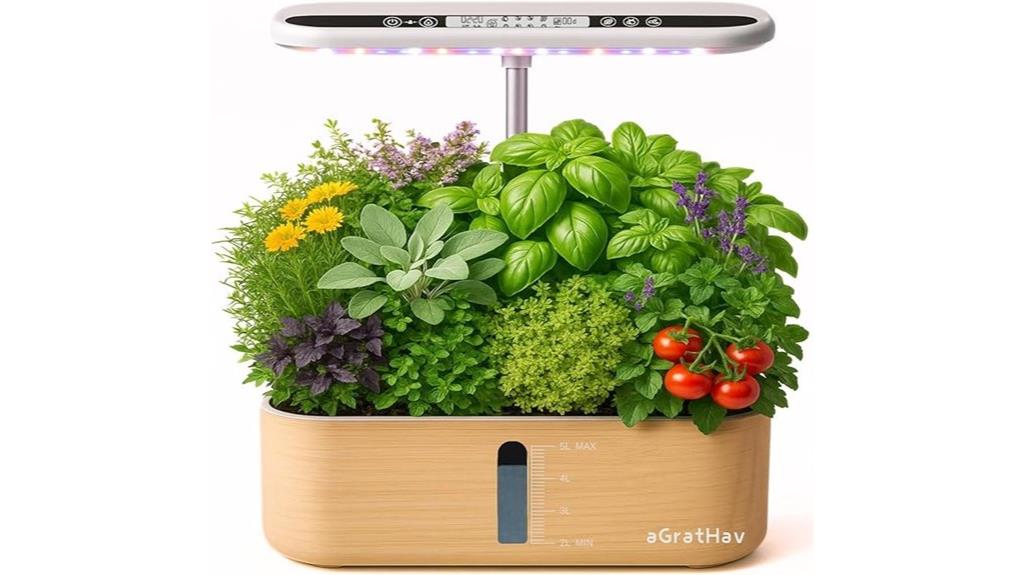
A Hydroponics Growing System Kit for Indoor Gardens offers a sleek, compact design that’s perfect for chefs looking to cultivate fresh herbs, vegetables, and fruits right in their kitchens. It features 14 pods, a built-in water reservoir, circulation system, and overhead LED grow light, creating a controlled environment for faster, healthier plant growth without soil or mess. The upgraded LCD display shows lighting modes, planting days, and real-time temperature, while child lock enhances safety. With adjustable lighting and smart timers, it’s easy to customize for leafy greens or flowering plants. This all-in-one system simplifies indoor gardening, making fresh ingredients conveniently accessible for culinary creations.
Best For: home chefs, gardening beginners, and indoor plant enthusiasts seeking an easy, mess-free way to grow fresh herbs, vegetables, and fruits year-round.
Pros:
- Fully automated with smart timers and LCD display for easy operation
- Compact design ideal for countertop use in kitchens, homes, and offices
- Promotes healthier plant growth with full-spectrum LED lighting and controlled environment
Cons:
- Limited to 14 plant pods, which may not satisfy large-scale gardening needs
- Requires periodic refilling of water reservoir and maintenance of circulation system
- May have a learning curve for those unfamiliar with hydroponic systems
DUNCHATY Stackable Planter with Garen Tool Set
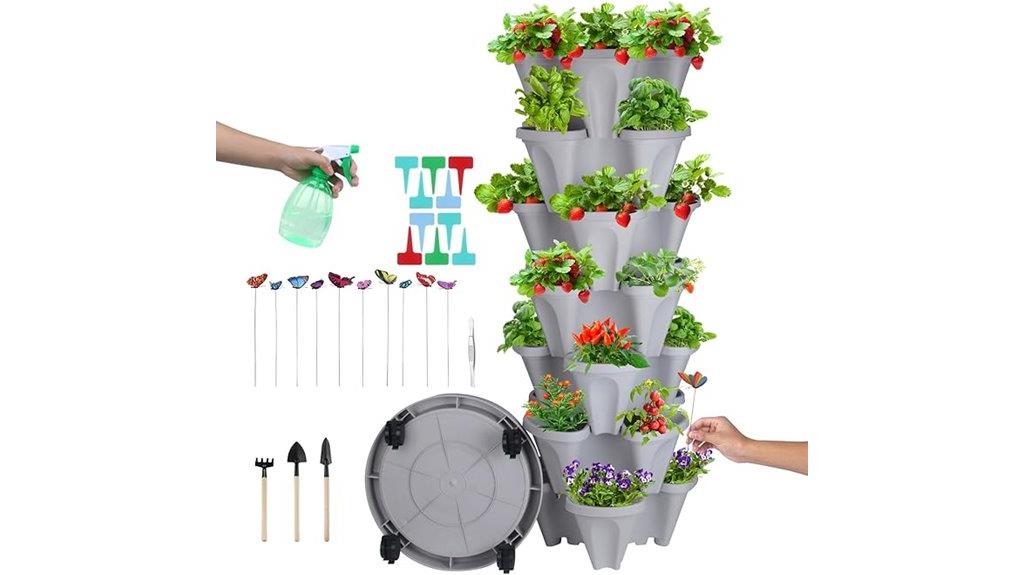
Designed with versatility in mind, the DUNCHATY Stackable Planter with Garen Tool Set is perfect for chefs who want fresh herbs readily accessible in their kitchens or dining spaces. Its 7-tier design allows for customizable stacking, and you can add more tiers as needed. The gray color adds a sleek look, while four wheels make it easy to move around. The self-watering system and drainage holes ensure healthy soil and roots, reducing maintenance. Plus, the included 25-piece garden tool set simplifies planting and tending. Whether indoors or outdoors, this modular, scalable planter keeps herbs within arm’s reach, elevating your culinary creations with fresh, homegrown ingredients.
Best For: home chefs, gardening enthusiasts, and anyone seeking an easy, scalable way to grow fresh herbs indoors or outdoors.
Pros:
- Modular 7-tier design allows customizable stacking and expansion with additional tiers.
- Equipped with four durable wheels for effortless mobility and repositioning.
- Includes a comprehensive 25-piece garden tool set, simplifying planting and maintenance.
Cons:
- May require assembly and some space for optimal use due to its multi-tier structure.
- The self-watering system and drainage features might need regular checking to ensure proper functioning.
- The gray color, while sleek, may not match all interior or outdoor décor themes.
MCombo 2-Tier Wooden Cold Frame Garden Greenhouse
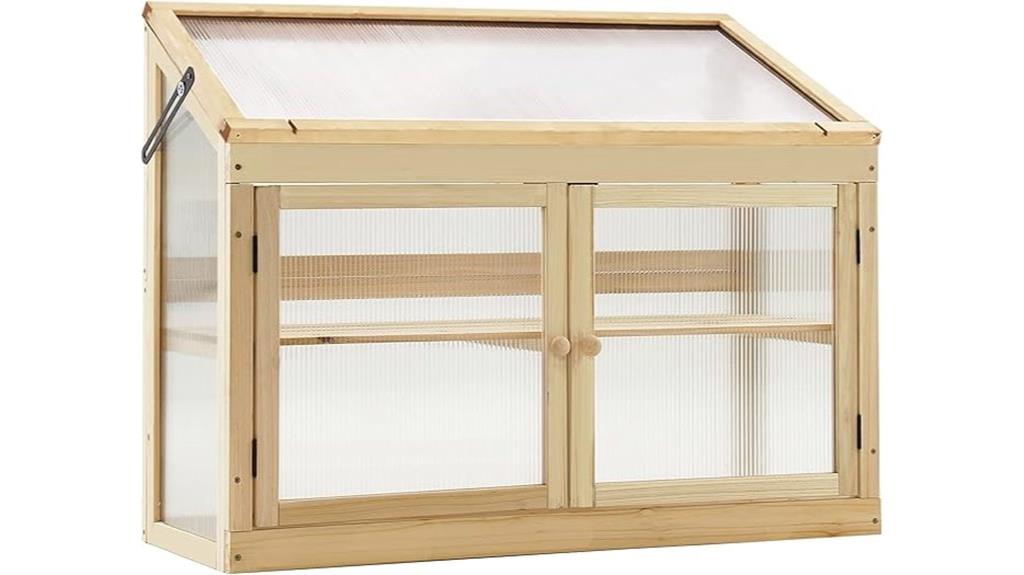
The MCombo 2-Tier Wooden Cold Frame Garden Greenhouse is perfect for chefs who want to cultivate fresh herbs and delicate greens indoors or in outdoor settings. Made from polished fir wood, it offers a rustic look while providing two tiers for organized plant growth and protection. The adjustable shelves let me customize height according to plant needs, and I can easily create additional holes for personalized setup. Its openable roof and adjustable vents ensure proper airflow, while grooves in the roof prevent rainwater buildup, making it suitable for outdoor use. Four metal brackets add stability and safety during outdoor gardening, making this greenhouse a versatile addition to any culinary space.
Best For: home gardeners, chefs, and outdoor enthusiasts seeking a sturdy, customizable greenhouse for growing herbs and greens in outdoor or indoor settings.
Pros:
- Made from durable, polished fir wood with a rustic aesthetic
- Adjustable shelves and customizable ventilation for optimal plant growth
- Designed with grooves and metal brackets for stability and rainwater drainage
Cons:
- Requires assembly and potentially some DIY adjustments for personalized setup
- Openable roof and vents may need regular maintenance to ensure proper function
- Limited to the size of the included two tiers, which may restrict large plant cultivation
Factors to Consider When Choosing Indoor Gardens for Chefs
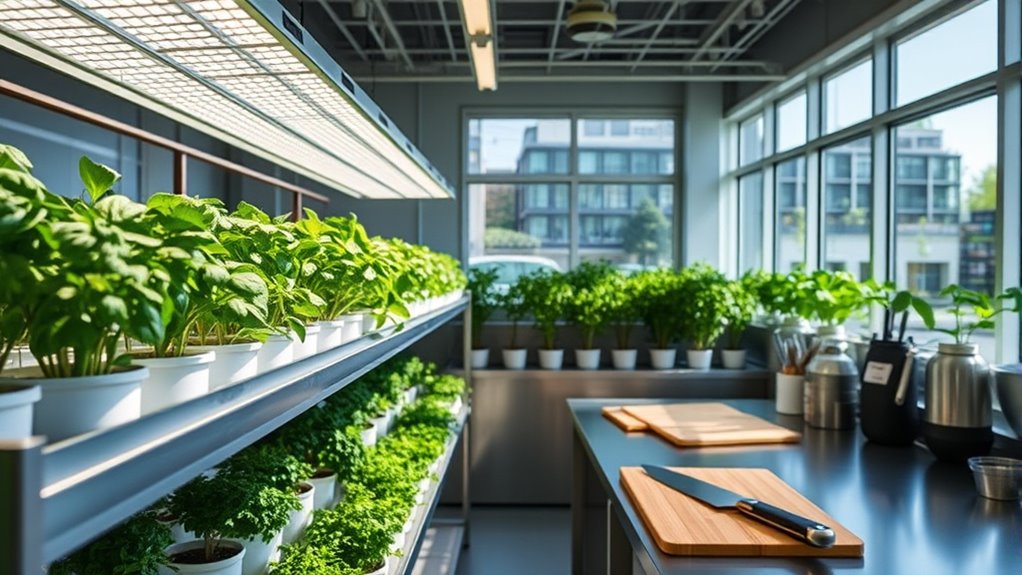
When choosing an indoor garden, I focus on how well it fits my space and lighting needs to guarantee my plants thrive. I also consider the variety of plants I want to grow and how easy it is to maintain the setup within my budget. These factors help me select the best garden system to support my culinary creativity.
Space Efficiency Needs
Choosing an indoor garden system that fits your space requires careful evaluation of your kitchen or workspace layout. I start by examining the available area to determine if a compact or multi-tiered system best suits my needs. Vertical gardening options, like stackable planters or wall-mounted setups, help maximize limited footprints. Measuring ceiling heights and countertop dimensions ensures the system can be installed and maintained without obstructing movement or access. I prefer modular or expandable gardens, so I can adjust or increase my setup as space evolves. Additionally, I prioritize systems with integrated lighting and water management, which save space and reduce equipment clutter. This thoughtful approach ensures my indoor garden is both functional and efficient within my available space.
Lighting Requirements
Optimizing the lighting setup is key to ensuring my indoor garden thrives. I use full-spectrum LED grow lights that mimic natural sunlight, which is essential for proper photosynthesis and healthy plant development. Adjustable lighting height and timers help me tailor light exposure to different growth stages, maximizing yield and flavor. I typically maintain consistent light cycles of 12 to 18 hours daily, promoting robust growth and preventing etiolation. Dimming features and programmable timers give me precise control over light intensity and duration, reducing energy consumption and ensuring my plants get the right amount of light. Proper lighting not only boosts growth but also enhances the flavor and quality of my herbs and vegetables, making my indoor garden a true culinary asset.
Plant Variety Options
Selecting the right plant varieties for an indoor garden involves considering the plants’ growth habits, culinary uses, and environmental needs. I focus on herbs, leafy greens, and vegetables that thrive in controlled environments, ensuring a steady supply of fresh ingredients year-round. Choosing diverse varieties allows me to maximize versatility and flavor, while quick-growing plants with high yields help optimize space and productivity. I prefer heirloom and non-GMO seeds to prioritize flavor, nutrition, and sustainability. Including flowering herbs and edible plants not only enhances the garden’s visual appeal but also expands culinary options. By carefully selecting plant varieties suited for indoor conditions, I can create a vibrant, efficient garden that elevates my culinary creations and maintains a consistent supply of fresh, flavorful ingredients.
Maintenance Ease
When setting up an indoor garden for a busy kitchen, ease of maintenance becomes a top priority. Automated watering systems cut down on daily effort, ensuring plants stay healthy without constant attention. Easily accessible containers and clear labels make tasks like pruning, harvesting, and adding nutrients quick and straightforward. Systems with built-in timers for lighting and climate controls reduce manual adjustments, keeping conditions stable. Compact, modular setups make cleaning and reorganizing simple, minimizing disruption. Low-maintenance features like self-watering or self-fertilizing components further decrease the time and effort required to keep your garden thriving. These options help busy chefs focus on their craft without being bogged down by constant garden upkeep, making indoor gardens a practical addition to any professional kitchen.
Budget Constraints
Setting a clear budget before choosing an indoor garden guarantees you select options that fit your financial limits and prevent overspending. I recommend establishing a range that covers initial setup costs—like containers, equipment, and plants—as well as ongoing expenses such as nutrients and electricity. For limited budgets, cost-effective choices like DIY hydroponic kits or seed starting setups can deliver great results without breaking the bank. Keep in mind that high-end automated systems and advanced lighting solutions can considerably increase your investment, so they may not be suitable if funds are tight. To ensure sustainability, balance your budget with the scale and complexity of the garden you want. This approach helps you create a functional, manageable indoor garden that aligns with your financial situation.
Growth Speed Factors
Growth speed in indoor gardens hinges on several critical factors that chefs should consider to maximize efficiency. First, the type of lighting matters—full-spectrum LED lights that mimic natural sunlight promote faster growth. Proper environmental control, including temperature and humidity regulation, directly influences plant metabolism and development rates. Automated watering and nutrient systems help maintain consistent moisture and nutrient levels, further speeding up growth. Additionally, selecting plant varieties with quick-maturing genetic traits can considerably reduce harvest times. Keep in mind that ideal conditions—like the right light spectrum, stable temperature, and humidity—are essential for rapid growth. By paying attention to these factors, you can choose an indoor garden setup that accelerates your culinary herb and vegetable production, ensuring fresher ingredients with less wait.
Aesthetic Appeal
Choosing an indoor garden that complements your kitchen’s design can transform your culinary space into an inspiring environment. The visual appeal, including color schemes and plant arrangements, can enhance your decor and make your kitchen feel more welcoming. I find that sleek, modern structures with clean lines work well in contemporary kitchens, adding a sophisticated touch. Incorporating decorative elements like stylish planters or subtle lighting can elevate the setup and spark creativity. It’s crucial to consider the size and shape of the garden, ensuring it fits harmoniously within your space without disrupting the flow. A well-chosen indoor garden not only looks beautiful but also inspires me to experiment and elevate my culinary creations every day.
Frequently Asked Questions
What Are the Best Herbs for Culinary Use in Indoor Gardens?
When it comes to herbs for culinary use in indoor gardens, I love growing basil, mint, and parsley because they’re versatile and fresh. Thyme and rosemary are fantastic for adding depth to dishes, and cilantro is a must for many cuisines. I find that these herbs are easy to maintain indoors, providing me with fresh flavors all year round, right at my fingertips.
How Much Light Do Different Kitchen Herbs Require Indoors?
Did you know herbs like basil need at least 6 hours of direct sunlight daily? For indoor kitchen herbs, I recommend placing them near south-facing windows for ideal light. Some herbs, like mint, tolerate lower light and can survive with 4 hours, but most thrive with 6-8 hours of bright, direct or indirect sunlight. If natural light is limited, I suggest using grow lights for better growth and flavor.
Can Indoor Gardens Support Edible Flowers for Garnishes?
Indoor gardens can definitely support edible flowers for garnishes. I’ve grown pansies, nasturtiums, and violets indoors, and they thrive in bright, indirect light. Just make sure they get enough sunlight or supplemental grow lights, and keep the soil moist. With a little care, you’ll have fresh, beautiful edible flowers to elevate your dishes right at home or in your kitchen.
What Are the Common Pests in Indoor Herb Gardens?
When it comes to indoor herb gardens, pests like aphids, spider mites, and whiteflies are common troublemakers. I’ve dealt with these myself, and I find that regular inspections and maintaining good airflow help prevent infestations. I also use natural solutions like neem oil or insecticidal soap to keep pests at bay. Staying vigilant and proactive is key to keeping my herbs healthy and pest-free, ensuring my culinary creations stay first-rate.
How Do I Maintain Optimal Humidity Levels for Indoor Edible Plants?
Did you know that maintaining proper humidity can boost plant growth by up to 50%? To keep ideal humidity levels, I suggest using a hygrometer to monitor moisture. I regularly mist my plants with water, use a humidifier, or place a tray of water nearby to increase humidity. Ensuring good air circulation and avoiding dry, heated environments also helps my edible plants stay healthy and flavorful.
Conclusion
Choosing the right indoor garden is like planting a seed of creativity in your kitchen. With the right tools, you can nurture fresh herbs and veggies year-round, transforming your culinary craft into a blooming masterpiece. Remember, each garden option is a stepping stone toward culinary mastery—so pick the one that grows with your passion. After all, your kitchen can become a lush oasis where flavors blossom and inspiration flourishes.
